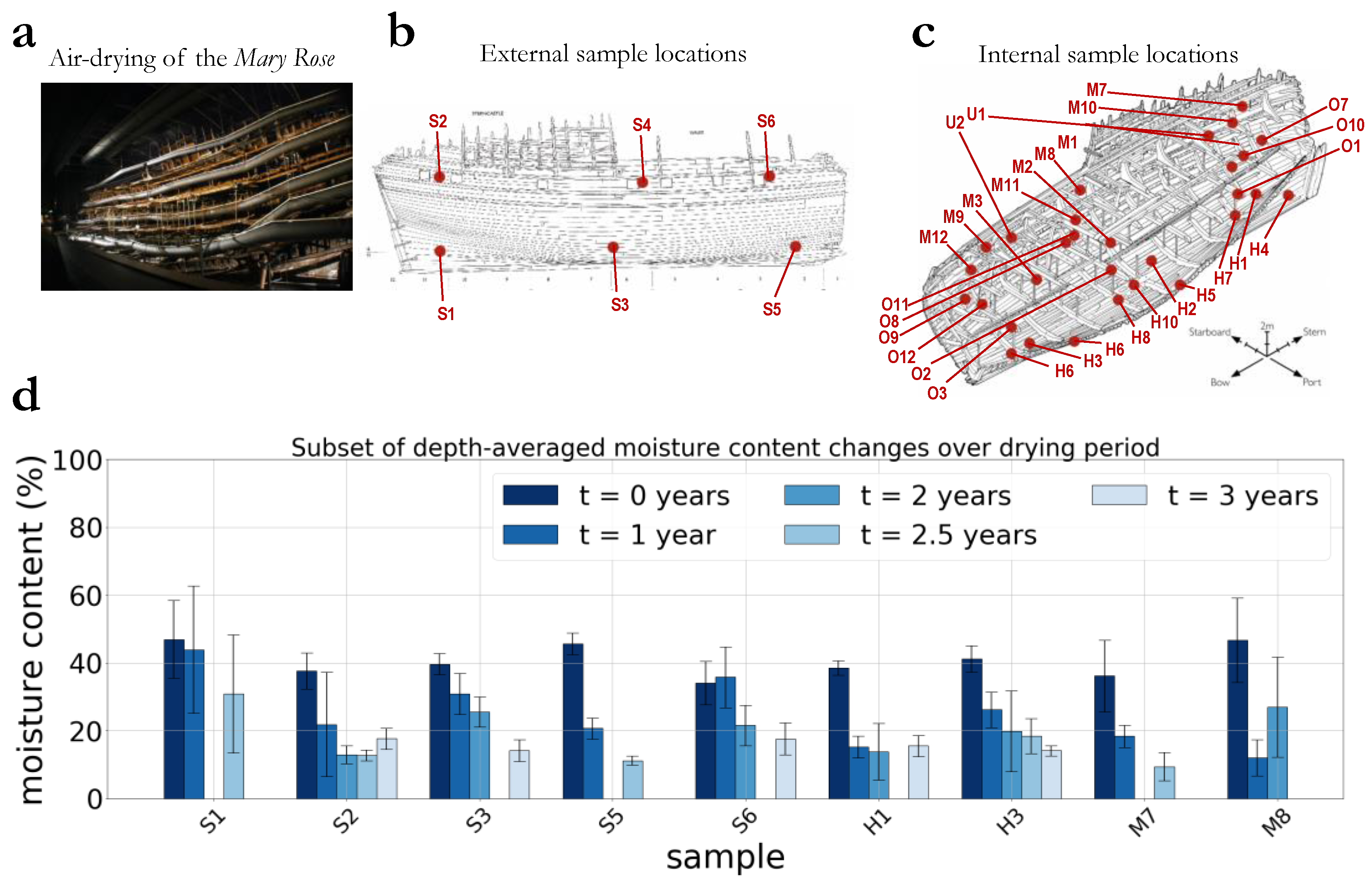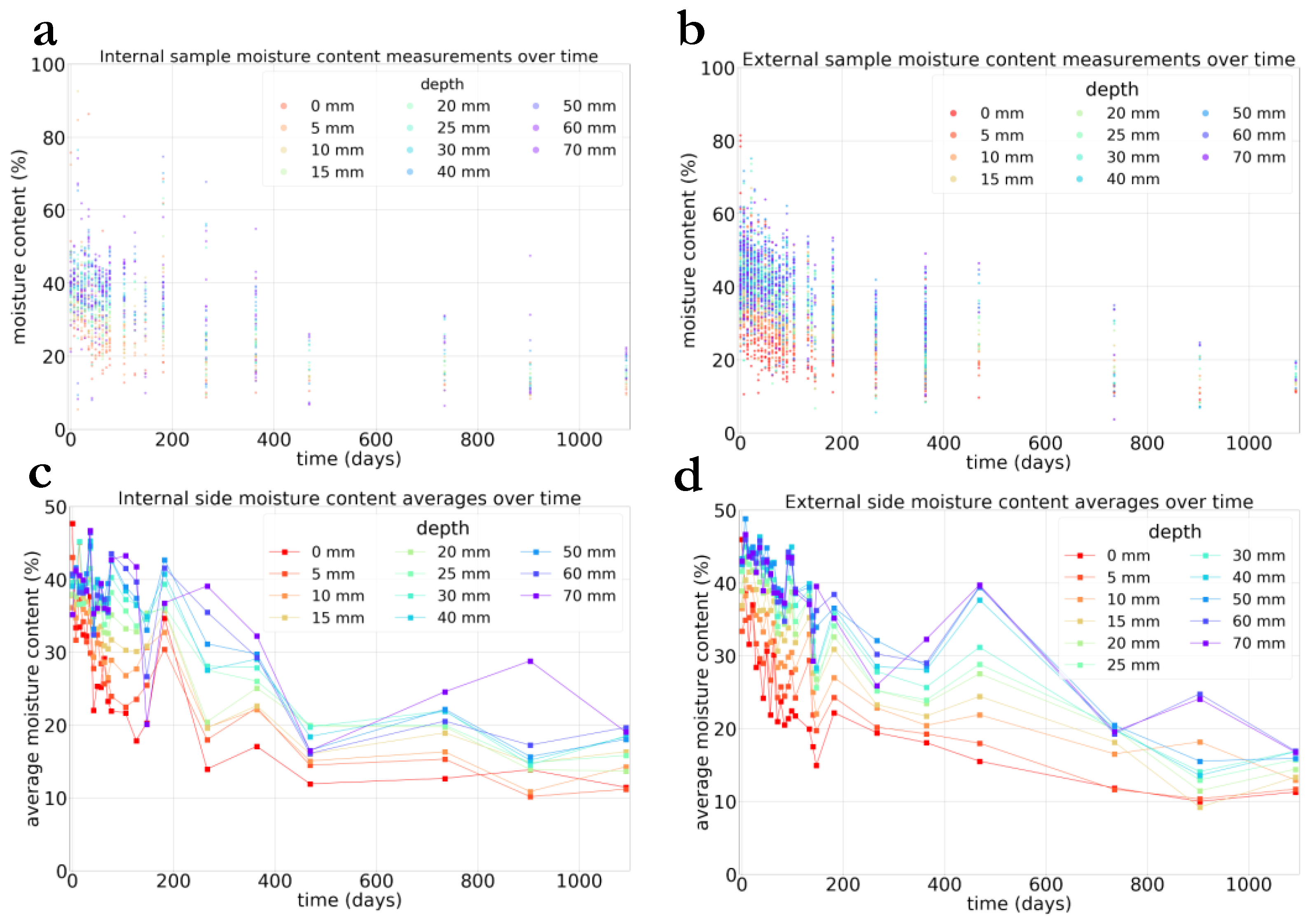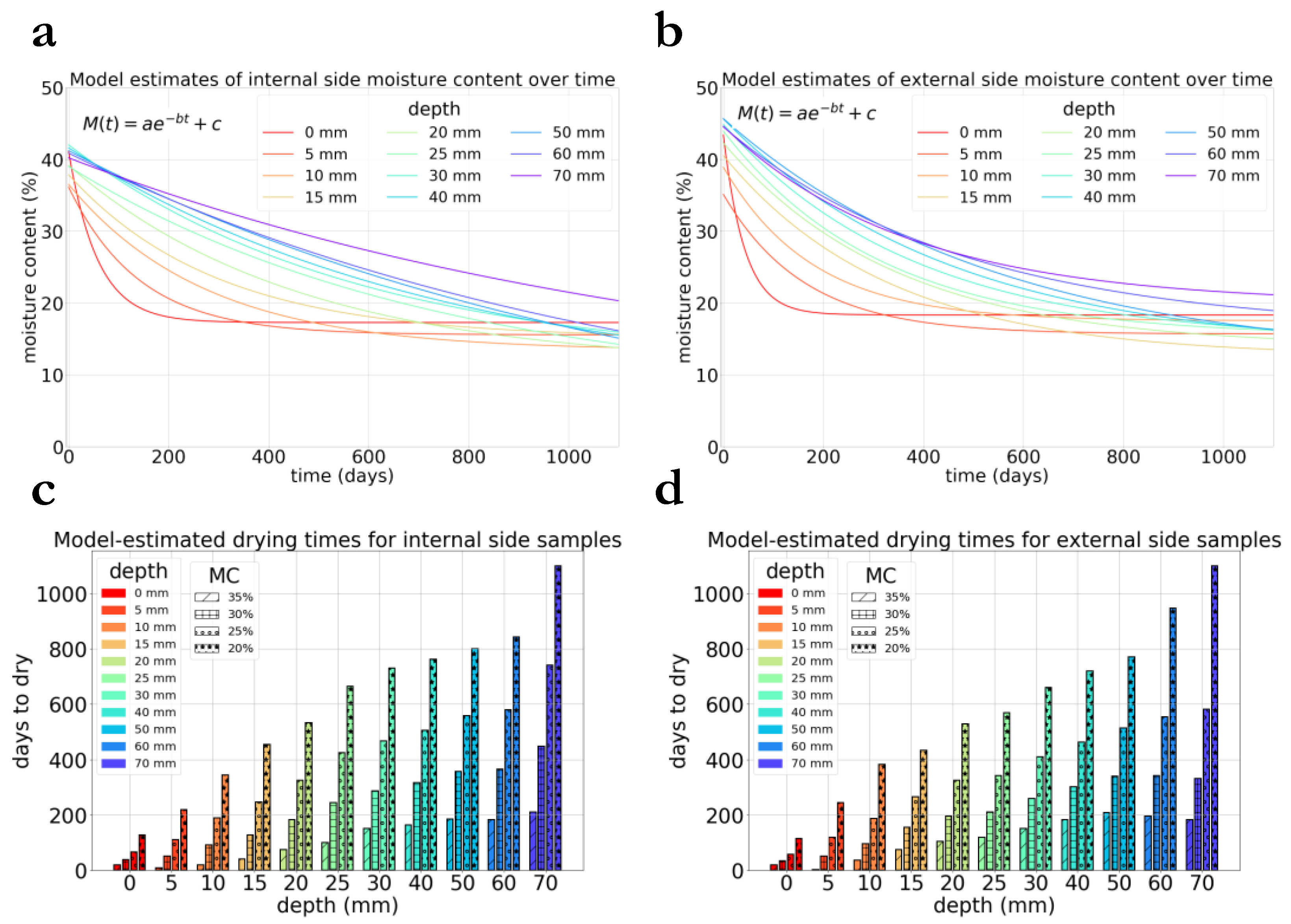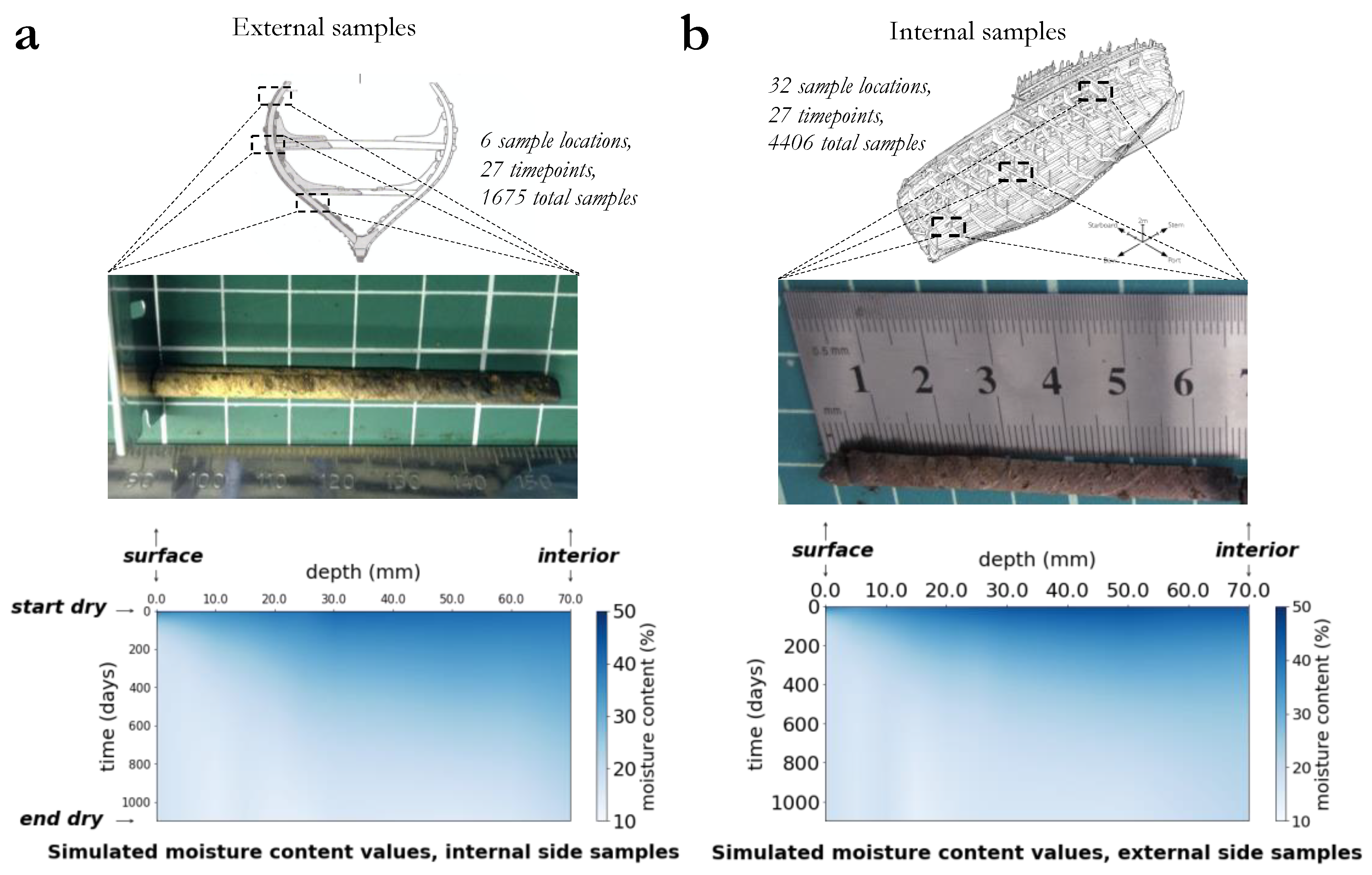Numerical Modelling of Moisture Loss during Controlled Drying of Marine Archaeological Wood
Abstract
:1. Introduction
2. Materials and Methods
2.1. Observational Measurements
2.2. Computational Modelling
3. Results and Discussion
3.1. Raw Data Describing the Drying of the Mary Rose
3.2. Numerical Modelling of the Drying of the Mary Rose
4. Conclusions
Supplementary Materials
Author Contributions
Funding
Institutional Review Board Statement
Informed Consent Statement
Data Availability Statement
Acknowledgments
Conflicts of Interest
References
- Caple, C. Conservation Skills–Judgement, Method and Decision Making; Routledge: Abingdon, UK, 2000. [Google Scholar]
- Grattan, D.W. Waterlogged Wood. In Conservation of Marine Archaeological Objects; Pearson, C., Ed.; Butterworths Heinemann: Oxford, UK, 1987. [Google Scholar]
- Florian, M.E. Scope and History of Archaeological Wood. In Archaeological Wood–Properties, Chemistry and Preservation; Advances in Chemistry Series; American Chemical Society: Washington, DC, USA, 1990; Volume 225. [Google Scholar]
- Rosenqvist, A.M. The Stabilizing of Wood Found in the Viking Ship of Oseberg: Part I. Stud. Conserv. 1959, 4, 13–22. [Google Scholar] [CrossRef]
- Hoffmann, P. To Be and to Continue Being a Cog: The Conservation of the Bremen Cog of 1380. Int. J. Naut. Archaeol. 2001, 30, 129–140. [Google Scholar] [CrossRef]
- Jones, M.A. For Future Generations: Conservation of a Tudor Maritime Collection; Mary Rose Trust: Portsmouth, UK, 2011; ISBN 1-78570-155-X. [Google Scholar]
- Ambrose, W.R. Application of Freeze-Drying to Archaeological Wood. In Archaeological Wood–Properties, Chemistry and Preservation; Advances in Chemistry Series; Rowell, R.M., Barbou, R.J., Eds.; American Chemical Society: Washington, DC, USA, 1990; Volume 225. [Google Scholar]
- Håfors, B. Conservation of the Swedish Warship Vasa from 1628; The Vasa Museum: Stockholm, Sweden, 2000. [Google Scholar]
- Vorobyev, A.; Almkvist, G.; van Dijk, N.P.; Gamstedt, E.K. Relations of Density, Polyethylene Glycol Treatment and Moisture Content with Stiffness Properties of Vasa Oak Samples. Holzforschung 2017, 71, 327–335. [Google Scholar] [CrossRef]
- Vorobyev, A.; van Dijk, N.P.; Kristofer Gamstedt, E. Orthotropic Creep in Polyethylene Glycol Impregnated Archaeological Oak from the Vasa Ship: Results of Creep Experiments in a Museum-like Climate. Mech. Time-Depend. Mater. 2019, 23, 35–52. [Google Scholar] [CrossRef] [Green Version]
- van Dijk, N.P.; Gamstedt, E.K.; Bjurhager, I. Monitoring Archaeological Wooden Structures: Non-Contact Measurement Systems and Interpretation as Average Strain Fields. J. Cult. Herit. 2016, 17, 102–113. [Google Scholar] [CrossRef]
- Schofield, E.J.; McConnachie, G.; Jones, M. Air Drying of the Mary Rose Hull; ICOM-CC: Paris, France, 2013. [Google Scholar]
- Hoffmann, P. On the Long-Term Visco-Elastic Behaviour of Polyethylene Glycol (PEG) Impregnated Archaeological Oak Wood. Holzforschung 2010, 64, 725–728. [Google Scholar] [CrossRef]
- Marsden, P. Understanding the Mary Rose. In Mary Rose: Your Noblest Shippe. Anatomy of a Tudor Warship; Mary Rose Trust: Portsmouth, UK, 2009; Volume 2, ISBN 0-9544029-2-8. [Google Scholar]
- McConnachie, G. Air Drying Behaviour of Waterlogged Archaeological Woods from the Tudor Warship Mary Rose. Ph.D. Thesis, University of Portsmouth, Portsmouth, UK, 2005. [Google Scholar]
- Macchioni, N.; Pecoraro, E.; Pizzo, B. The Measurement of Maximum Water Content (MWC) on Waterlogged Archaeological Wood: A Comparison between Three Different Methodologies. J. Cult. Herit. 2018, 30, 51–56. [Google Scholar] [CrossRef]
- Håfors, B.; Persson, U. Monitoring Changes in Water Content of the Vasa Wood with a Resistance Meter. In Proceedings of the 6th ICOM Group on Wet Organic Archaeological Materials Conference, York, UK, 9–13 September 1996; Schiffahrtsmuseum: Bremerhaven, Germany, 1997; pp. 35–45. [Google Scholar]
- Piva, E. Conservation of a Tudor Warship: Investigating the Timbers of the Mary Rose; Mary Rose Trust: Portsmouth, UK, 2017. [Google Scholar]
- Schofield, E.J. Illuminating the Past: X-ray Analysis of Our Cultural Heritage. Nat. Rev. Mater. 2018, 3, 285–287. [Google Scholar] [CrossRef]
- Piva, E. Structural Conservation of the Tudor Warship Mary Rose. Ph.D. Thesis, University of Portsmouth, Portsmouth, UK, 2017. [Google Scholar]
- Hocker, E.; Almkvist, G.; Sahlstedt, M. The Vasa Experience with Polyethylene Glycol: A Conservator’s Perspective. J. Cult. Herit. 2012, 13, S175–S182. [Google Scholar] [CrossRef]
- Babiński, L.; Izdebska-Mucha, D.; Waliszewska, B. Evaluation of the State of Preservation of Waterlogged Archaeological Wood Based on Its Physical Properties: Basic Density vs. Wood Substance Density. J. Archaeol. Sci. 2014, 46, 372–383. [Google Scholar] [CrossRef] [Green Version]
- McConnachie, G. A Re-Evaluation of the Use of Maximum Moisture Content Data for Assessing the Condition of Waterlogged Archaeological Wood. e-Preserv. Sci. 2008, 5, 29–35. [Google Scholar]
- Håfors, B. The Drying Pattern of the Outer Planking of the Wasa Hull. In Proceedings of the 2nd ICOM Waterlogged Wood Working Group Conference, Grenoble, France, 28–31 August 1984; Centre d’Étude et de Traitement des Bois Gorgés d’Eau: Grenoble, France, 1984; pp. 313–326. [Google Scholar]
- Klügl, J.; Di Pietro, G. The Interaction of Water with Archaeological and Ethnographic Birch Bark and Its Effects on Swelling, Shrinkage and Deformations. Herit. Sci. 2021, 9, 3. [Google Scholar] [CrossRef]
- Walsh, Z.; Janeček, E.-R.; Jones, M.; Scherman, O.A. Natural Polymers as Alternative Consolidants for the Preservation of Waterlogged Archaeological Wood. Stud. Conserv. 2017, 62, 173–183. [Google Scholar] [CrossRef] [Green Version]
- Henrik-Klemens, Å.; Abrahamsson, K.; Björdal, C.; Walsh, A. An In Situ Raman Spectroscopic Method for Quantification of Polyethylene Glycol (PEG) in Waterlogged Archaeological Wood. Holzforschung 2020, 74, 1043–1051. [Google Scholar] [CrossRef] [Green Version]
- Aluri, E.R.; Reynaud, C.; Bardas, H.; Piva, E.; Cibin, G.; Mosselmans, J.F.W.; Chadwick, A.V.; Schofield, E.J. The Formation of Chemical Degraders during the Conservation of a Wooden Tudor Shipwreck. ChemPlusChem 2020, 85, 1632–1638. [Google Scholar] [CrossRef] [PubMed]




Publisher’s Note: MDPI stays neutral with regard to jurisdictional claims in published maps and institutional affiliations. |
© 2021 by the authors. Licensee MDPI, Basel, Switzerland. This article is an open access article distributed under the terms and conditions of the Creative Commons Attribution (CC BY) license (https://creativecommons.org/licenses/by/4.0/).
Share and Cite
Lipkowitz, G.; Hennum, K.S.; Piva, E.; Schofield, E. Numerical Modelling of Moisture Loss during Controlled Drying of Marine Archaeological Wood. Forests 2021, 12, 1662. https://doi.org/10.3390/f12121662
Lipkowitz G, Hennum KS, Piva E, Schofield E. Numerical Modelling of Moisture Loss during Controlled Drying of Marine Archaeological Wood. Forests. 2021; 12(12):1662. https://doi.org/10.3390/f12121662
Chicago/Turabian StyleLipkowitz, Gabriel, Karoline Sofie Hennum, Eleonora Piva, and Eleanor Schofield. 2021. "Numerical Modelling of Moisture Loss during Controlled Drying of Marine Archaeological Wood" Forests 12, no. 12: 1662. https://doi.org/10.3390/f12121662
APA StyleLipkowitz, G., Hennum, K. S., Piva, E., & Schofield, E. (2021). Numerical Modelling of Moisture Loss during Controlled Drying of Marine Archaeological Wood. Forests, 12(12), 1662. https://doi.org/10.3390/f12121662





